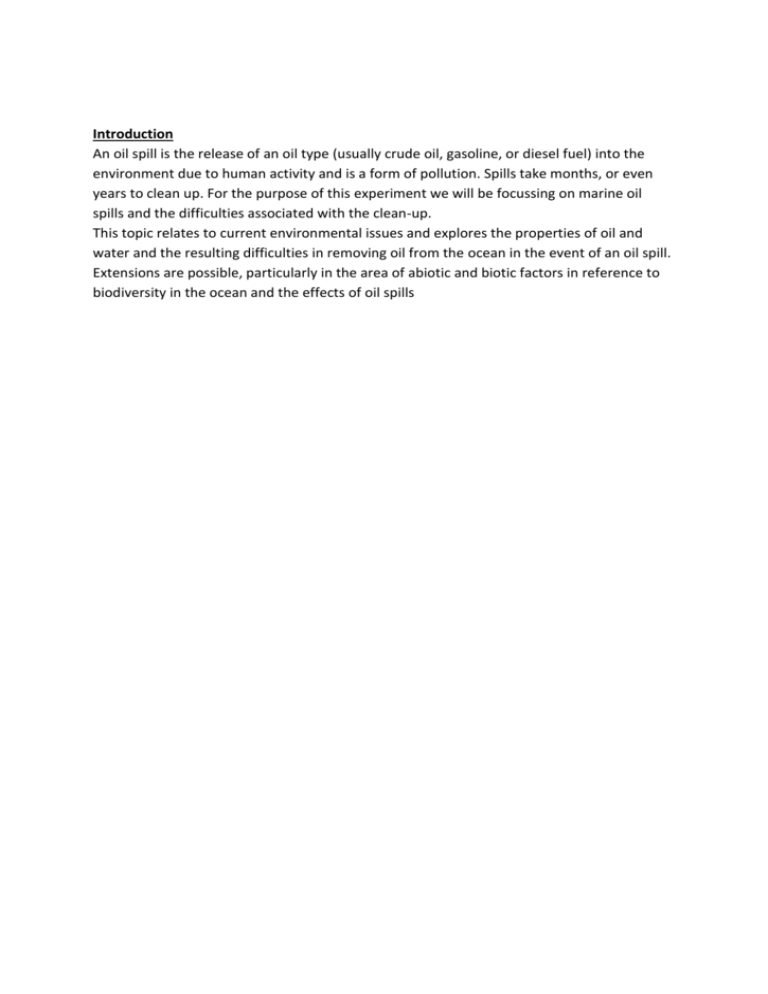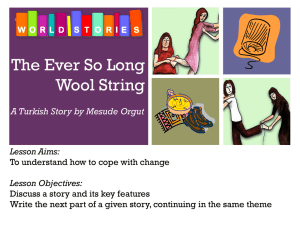Oil spill sxperiment - ltu
advertisement

Introduction An oil spill is the release of an oil type (usually crude oil, gasoline, or diesel fuel) into the environment due to human activity and is a form of pollution. Spills take months, or even years to clean up. For the purpose of this experiment we will be focussing on marine oil spills and the difficulties associated with the clean-up. This topic relates to current environmental issues and explores the properties of oil and water and the resulting difficulties in removing oil from the ocean in the event of an oil spill. Extensions are possible, particularly in the area of abiotic and biotic factors in reference to biodiversity in the ocean and the effects of oil spills VELS References (level 3) Knowledge and understanding Standard “They describe....human influences in the environment, which affect the survival of living things” Progression point 2.75 Understanding of events which may affect the sustainability of interactions occurring between living (biotic) and non-living (abiotic) components of the environment Science at work Standard “They explain how scientific knowledge is used, or could be used, to solve a social issue or problem.” Progression point 2.5 Knowledge of the science involved in a social issue or problem Purpose To test the effectiveness of different materials and methods used to remove oil from water. Hypothesis 1. When using only one material, cotton balls will be the most effective at removing oil from the water. 2. Using multiple materials, the combined use of string and cotton balls will be most effective at removing oil from the water. Materials Measuring cup (1/3) Square casserole dish Olive oil Cat litter (synthetic crystal kind) Cotton wool balls Piece of nylon stocking Piece of cardboard Piece of household sponge Paper towels Pipette Spoon String Cold fresh water Method 1. Casserole dish was filled with cold tap water to approximately 3cm from the top. 2. 1/3 cup of olive oil was added. 3. The above (control) process was repeated before using each of the materials; cat litter, cotton wool balls, nylon stocking, cardboard, sponge, pipette, spoon, paper towels, and string, to remove the oil from the water. A time limit of 1 minute was set for each clean-up. 4. Before and after pictures were taken for each material using digital camera. Results Figure 1: Control Figure 2: Materials used & Results Material Used Pipette Household sponge Teaspoon After 1 Minute of Cleaning Nylon stocking Cardboard String Cotton Wool Paper towel Cat litter String and Cotton Wool Figure 3: Points of Interest 1.Large piece of paper towel 2. Results after paper towel 3.String and cat litter 4.Oil soaked cardboard 5.Cat litter aerating the oil 6.Left over refuse from clean up Discussion Figure 2 As can be seen by looking at figure 2 in the results, part one of the hypothesis was proven incorrect. The cotton wool balls did absorb a good amount of oil. However, they do not have a very large surface area, so it was difficult to put them into contact with all of the dispersed oil. Another limiting factor was that the oil was only absorbed into the outer surface of the cotton wool ball, rendering much of its’ mass ineffective. Water was also inadvertently absorbed with the oil, again, reducing the cotton wool ball’s effectiveness. The paper towel was much more effective at removing the oil from the water. By laying it down lightly, much of the oil, and a minimal amount of water was absorbed into the paper towel. The larger surface area and easier application of the paper towel made it the most effective material in removing the oil from the water. The cat litter did not absorb any oil, perhaps due to the nature of the crystals. More research would need to be conducted on the structure of the crystals. Part 2 of the hypothesis was also proven incorrect. Though the string was very effective at pooling the oil together at the end of the dish, the cotton wool balls proved difficult to manoeuvre and not as absorbent as hoped. Three large paper towels removed almost all of the oil from the casserole dish. The only oil it did not remove was the oil that clung to the sides of the dish. This is comparable to a shore-line in a real oil spill. Further studies on removal of oil from a solid surface would need to be conducted to discover effective ways of removing this. Advantages of different materials worth note (Figure 3): String – When dragged lightly across the surface of the water, the string pooled the oil in one isolated area at the end of the dish (Figure 3, caption 5.) This could be an effective technique when cleaning large oil spills. Cat litter – Aerated the surface of the oil/water which made the oil much more visible to the naked eye and seemed to pool it together. This could be useful when trying to target the oil. Cardboard – When lightly placed on top of the water, the cardboard floated, absorbing oil more readily that the water. Materials used in actual oil spills compare to the materials used in this experiment: Booms – string Skimmers – spoon Sorbents – sponge, paper towel, cotton wool balls, nylon stockings, cardboard Vacuums – pipette Photo 6. In figure 3 shows how messy the clean-up is and how much material is left over. Limitations Whilst successful at demonstrating the properties of the materials in removing oil from water, the experiment did not emulate actual application in an ocean environment. Variables that should be taken into consideration include: Ocean swell Weather Salt in the water Waves Shorelines Conclusion In the simulated oil spill with a one minute time limit, cotton wool on its’ own was not the most effective material for removing oil from the water. Using string to isolate the oil and cotton wool to absorb it worked more effectively, however, not all of the oil was removed. The most effective way to remove the oil using the materials in the experiment, was using the paper towel on its’ own. Delegation Patrick and Thea designed and undertook the experiment together. Thea took photos, Patrick cleaned oil. The write-up of the experiment was a joint effort.






